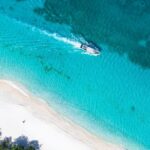If you plan to visit the Caribbean’s “Nature Island,” you’re probably in search of things to do in Dominica to make the most of your trip. Dominica’s true beauty and appeal lie in its untouched qualities, demonstrating why the island is one of the most beloved Caribbean countries. From bathing in natural hot springs and mud pools to hiking trails and tropical forests, this guide reveals the 15 best activities and places to visit in Dominica.
Top 15 Things to Do in Dominica
Natural attractions in Dominica
1. Dominica’s Boiling Lake
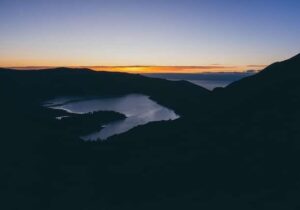
The lake is a flooded fumarole – a ground opening that emits steam and gases from volcanic activity – in the Valley of Desolation. The lake is often described as resembling a cauldron full of bubbling grey-blue water and surrounded by clouds of swirling vapor.
The hike to the lake – the Boiling Lake Trail – starts in the small village of Laudat and typically spans two to four hours, depending on your hiking expertise. The trail can become tricky to navigate due to the muddy, rugged terrain and precarious ridge, so it may be a good idea to head there with an experienced guide.
2. Trek the Waitukubuli National Trail
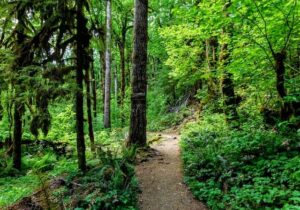
Waitukubuli National Trail is the only long-distance hiking trail in the Caribbean, with the entire route taking about two weeks to complete. However, each of its 14 segments presents its own unique challenges and level of difficulty. So, whether you’re looking for a (relatively) quick and easy, family-friendly trail or something more challenging, you have plenty of options.
365 rivers wind across the island, meaning you’re likely to encounter one during your hike and use it as a chance to cool off. The best way to enjoy this ultimate scenic excursion – where you can make your way through waterfalls, rivers, Kalinago villages, Maroon passages, and other natural sites – is with a group or guide.
3. Snorkel through Champagne Reef
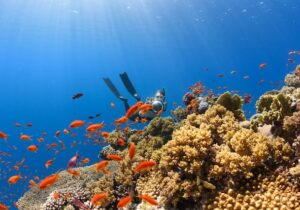
Champagne Reef on the west coast is one of Dominica’s most popular snorkeling locations. The reef is flat, extending from the shoreline and ending with a drop. These plummeting cliffs and towering volcanic formations perfectly match Dominica’s enormous mountains and gorges.
If you’d like to snorkel with hawksbill turtles, parrot and trumpet fish, sergeant majors, and blue tangs, then Champagne Reef is the perfect experience to do just that.
4. Cool off at Twin Trafalgar Falls
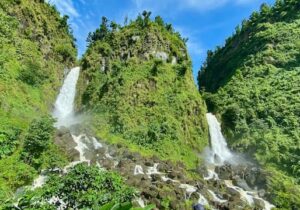
Mama is a smaller fall that offers refreshing water for the more daring swimmers. If you prefer to swim in warmer waters, look for the hot, clear mountain water from the taller Papa.
If you want to hike the falls, it is advisable to do so with a seasoned guide. The boulders are quite slippery from the water, making the climb slightly more challenging for those unfamiliar with the route. You will also want to start early to ensure optimal lighting.
5. Take a dip in the Emerald Pool
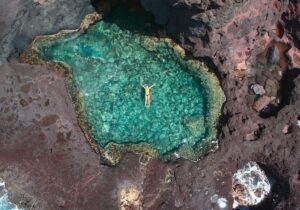
This unique color and drama have resulted in Emerald Pool being the backdrop of weddings and several movies, such as the Pirates of the Caribbean franchise.
If you’re in search of more unique things to do in the Caribbean, check out the sulphur springs and mud pools at Wotten Waven in Dominica’s Roseau Valley.

Fun Dominica activities
6. Stay in an eco-friendly luxury resort
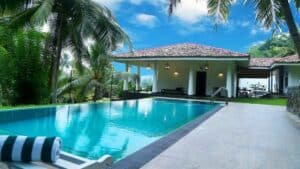
Jungle Bay Resort: Located in Soufrière, Jungle Bay is designed harmoniously with the landscape and handcrafted from local materials. Surrounded by the rainforest, the resort’s design and operations align with responsible tourism and environmental awareness. A stay here guarantees unmatched Eastern Caribbean Sea views and the surrounding jungle.
Sanctuary Rainforest Eco Resort & Spa: Sanctuary Rainforest Eco Resort and Spa is a government-approved real estate project under the Dominica citizenship by investment program. The resort is nestled in the rainforest of Laudat, Roseau Valley, which is also home to the Morne Trois Pitons National Park, a UNESCO World Heritage Site.
The resort consists of 72 environmentally friendly villas, organic food restaurants, and various facilities, such as a heated pool and pool bar.
Coulibri Ridge: Found in southern Dominica, Coulibri Ridge is made up of four luxury studios and duplexes that overlook the island of Martinique. Power is provided by solar energy and wind turbines, and rainwater is gathered, purified, and used to fill the resort’s two large main swimming pools and its private pools.
Additionally, the eco-resort and its owner founded two non-profit organizations on the island, one of which is Resilient Dominica (REZDM). Resilient Dominica supports local and self-sustainable projects and initially focused on work in response to Hurricane Maria and the damage it caused to the island’s infrastructure in 2017.
Secret Bay: Located in Portsmouth, this six-star, award-winning resort offers a variety of luxury residences to visitors. It is a Green Globe-certified resort composed entirely of sustainably sourced materials such as tropical hardwood. Secret Bay is committed to maintaining the land in the pristine condition it was founded in, employing people from neighboring communities, buying local produce, and supporting local artisans and businesses.
7. Explore Dominica by taste
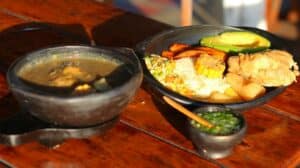
Dominica Chocolate Factory Tour and Taste: The Dominica Chocolate Factory Tour is the only place in Dominica where you can see chocolate making year-round. Here, you can learn all about the process of making chocolate and enjoy a unique tasting of locally grown beans.
The Art of Dominican Cooking in Roseau: Through this tour, you will experience the vibrant and the best food of Dominica cuisine, learn about the different herbs, spices, and products used in Dominican Creole cuisine, learn how to cook traditional dishes, and even explore the capital city of Roseau.
The central part of this tour revolves around a visit to a local home where a skilled chef will teach you about the history and cultural significance of local dishes, such as mofongo, sancocho, and arroz con Pollo, as well as how to cook them. You will get to sit down and enjoy the delicious meal you have cooked.
8. Cruise along the Indian River
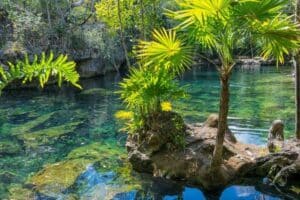
If you’re a fan of the Pirates of the Caribbean films, this is one of the best Dominica activities for you, as the colorful wooden rowboats and knowledgeable guides take you through the jungle hideaway of Tia Dalma, also known as Calypso.
Late afternoon is a nice time to go, especially if cruise ships are visiting. You just might catch the start of a stunning Dominica sunset while enjoying a dynamite punch at the Indian River Bar.
If you’re a fan of the water, you may also enjoy hopping on a cruise ship or catamaran and venturing out to some of Dominica’s neighboring Caribbean islands.
9. Challenge yourself with canyoning
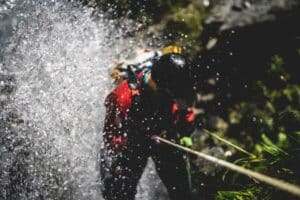
Canyoning refers to the act of navigating down a fast-flowing mountain stream in a gorge and is definitely one of the more unique things to do in Dominica. No experience is necessary, as experts will guide you through the process of what to do, but you should be comfortable with heights and a decent swimmer.
The required rappelling gear is provided and relatively easy to operate. You can build confidence on the practice wall before moving on to the real thing. The most popular canyoning route, suitable for most people, involves rappelling down multiple waterfalls and bounding into deep river pools before ending in the gorgeous Cathedral Canyon.
10. Scuba dive in the Soufriere Scotts Head Marine Reserve
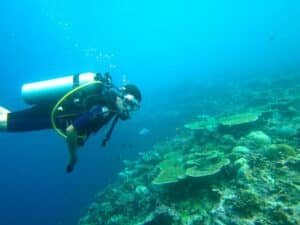
One of Dominica’s great attractions is that it is so well-preserved, and its coral reefs are no different. The cool, deep waters of the ocean have protected them from the kind of bleaching damage experienced elsewhere, leaving the formations in a pretty healthy condition. The majority of divers favor the protected Soufriere Scotts Head Marine Reserve, where sites such as Swiss Cheese and Cachacrou attract photographers of all kinds.
Immerse yourself in Dominican culture
11. Explore the streets of Roseau
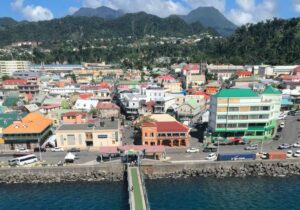
- The Dominica Museum
- Pebble’s Park
- Our Lady of Fairhaven Cathedral
- The Botanical Gardens
- Morne Bruce
- The city’s old slave market
Many agree that walking is the best way to explore a new place, and Dominica – with its lush rainforest, natural springs, stunning landscape, and friendly people – is an ideal Caribbean island to do just that.
12. Take part in the Dominica Jazz ‘N Creole Festival
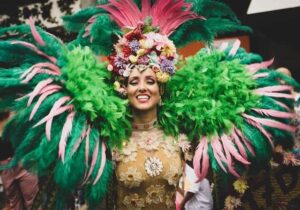
This family-friendly World Creole Music Festival has been held for more than a decade and takes place each year at Fort Shirley in Cabrits National Park. This event showcases some of the finest local musicians and features calypso competitions.
13. Visit the Morne Trois Pitons National Park
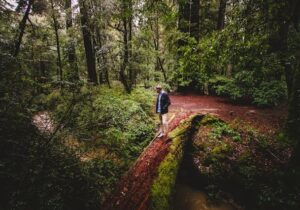
Morne Trois Pitons National Park boasts a variety of exceptional natural wonders. The park’s key attractions include the Valley of Desolation, the Boiling Lake, Titou Gorge, Freshwater Lake, Boeri Lake, Emerald Pool, Middleham Falls, Morne Anglaise, Morne Watt, and Morne Micotrin (Morne Macque).
14. Spend time in the Kalinago Territory
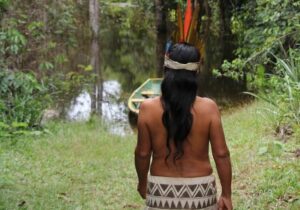
A day trip through the territory provides the perfect opportunity to experience Kalinago culture and tradition. For example, baskets are woven from river reeds, canoes are created from the trunks of giant gommier trees, and cassava bread is baked on open fires and hot plates.
Kalinago guides offer tours of the territory an insights into Kalinago culture, which include hikes along the Asulukati River and its waterfall and climbs to the peak of Kabet.
15. Explore Roseau Old Market
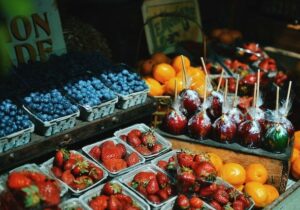
Situated in a cobblestone plaza, the busy market is frequented by locals and foreign visitors taking a break from the island’s beautiful beaches and nature. Visitors love to snap photos and explore the wooden stalls in Old Market Square filled with tropical fruits, spices, coffee, leather goods, woven baskets, and various trinkets.
Traveling Around Dominica
Dominica has two international airports: Canfield and Doglas-Charles Airport. Most visitors arrive in Douglas-Charles, but due to the lack of flight options, travelers largely rely on connecting flights from nearby islands like Guadeloupe. However, the new Dominica International Airport is currently under construction and promises to improve accessibility by offering direct routes from major international hubs in North America and Europe.
The island spans 29 miles through mountainous terrain. Taxi services are commonly used for transfers from Roseau to hotels and resorts. Car rental companies such as Sonar Rentals & Services, Pulse Car Rental, and Qwick Rentals Dominica offer a range of suitable vehicles for the terrain and a convenient way to explore Dominica’s best attractions.
Best time to visit Dominica?
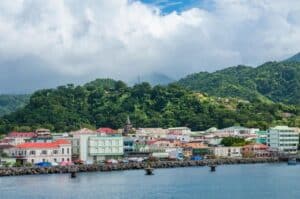
Consider the dry season, which runs from November to April, for warm and sunny weather every day. The wet season coincides with the Caribbean’s hurricane season, which can intensify adverse weather conditions without much notice.
If you want the best cultural experiences or events, the Dominica Carnival takes place at the end of February or the beginning of March. Dominica’s Jazz and Creole Festival is another popular event, which kicks off during the first week of May.
How much time should I spend in Dominica?
Dominica’s small size means one week is generally enough to travel around the island and experience its best activities. How long you stay depends on whether you like action-packed days or slow travel.
Where to stay in Dominica
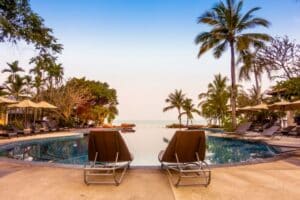
- Secret Bay: An award-winning five-star luxury resort featuring secluded villas and a yoga retreat.
- Rosalie Bay Eco Resort & Spa: An eco-friendly resort close to nature trails and the beach.
- Fort Young Hotel and Dive Resort: A seafront resort in Roseau that offers the island’s only all-inclusive service.
What to eat and drink in Dominica?
As more travelers discover Dominica, its food scene has gained more popularity. Local dishes you should try include Mountain Chicken (Coq des Bois), a delicacy made with a local frog species [not chicken] stewed with vegetables; Callaloo Soup, the island’s national dish, made with callaloo, okra, coconut milk, and salted meat or fish.
Dominican desserts include Tamarind Balls, a tangy ball made from tamarind pulp and sugar, and Sugar Cake, a sweet snack made with grated coconut, ginger, and bay leaves. For drinks, you should try to include soursop juice, cocoa tea, rum punch, and local beers like Kubuli.
Frequently Asked Questions about the Top Things to Do in Dominica
What are the must-visit natural attractions in Dominica?
Dominica is particularly attractive because of its untouched natural landscape. The must-see tourist attractions in Dominica include the Emerald Pool, the Boiling Lake, Titou Gorge, the Champagne Reef, Trafalgar Falls, and the 40-acre Botanic Gardens.
Is Dominica good for tourists?
Dominica is a safe Caribbean island for tourists and a good please to visit due its natural beautiful, from beautiful beaches like Mero Beach black sand beach to untouched forests like the Northern Forest Reserve.
What are the best activities for adventure enthusiasts in Dominica?
The best activities for adventure enthusiasts in Dominica include boat rides along the Indian River, hikes in the national parks, scuba diving and snorkeling in the ocean, and canyoning.
What cultural experiences can I have in Dominica?
There are many ways to experience Dominica’s culture, such as local food and drink tours, street tours, visiting cultural landmarks and museums, and doing a guided tour of the Kalinago Territory. It is worth visiting for an immersive cultural experience.
Can I go river tubing in Dominica?
Yes, you can go river tubing in Dominica at Hibiscus Eco-Village. You can also visit sulphur springs, a national park (e.g., Morne Trois Pitons and Cabrits National Park), historical sites (e.g., Fort Shirley), a World Heritage Site (Morne Trois Pitons National Park), a marine reserve (Scotts Head), and more.
When to Visit Dominica
The best time to visit Dominica is during the cooler, drier season, which falls between January and May. Temperatures and humidity begin to increase from mid-May, with June seeing the beginning of the rainy season. From June to September, the island experiences its rainy and hurricane seasons, especially between late August and early September.
What is Dominica best known for?
Dubbed the “Nature Island,” Dominica lives up to its name by untouched, featuring numerous hot springs, mountains, pristine tropical rainforests, and waterfalls like Victoria Falls. Besides lush forests, Dominica has fine white sand beaches like Pointe Baptiste and Batibou Beach line with palm trees.
How much money do I need for Dominica?
The ideal budget for a budget traveler visiting Dominica is $50 to $100 per day. This budget covers accommodation, food, travel, and activities. High-end travelers typically spend between $500 and $1,000 daily, depending on where they stay and their activities.
What are some free things to do in Dominica?
Free activities in Dominica include exploring the streets of Roseau and the Roseau Old Mark and spending time on the island’s beaches, such as Mero Beach and Batibou Beach.


